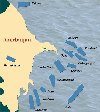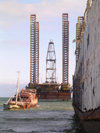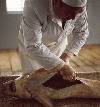| The
Azeri Economy |
Azerb.com
|
| |
|
Azerbaijan is less developed
industrially than either Armenia or Georgia, the other Transcaucasian states,
but the recent influx of Petrodollars is bringing change at a quic pace.
It resembles the Central Asian states in its majority nominally Muslim
population, high structural unemployment, and low standard of living. The
economy's most prominent products are oil, cotton,
and gas.
 Production
from the Caspian oil and gas fields declined for several years, but has
been recovering in the last few years. This is the consequence of the negotiation
of 21 major field agreements with 33 companies from 15 countries,
which have thus far committed $35 billion to oil field development. Such
investment should generate the funds needed to spur future industrial development.
Oil production under the first of these agreements, with the Azerbaijan
International Operating Company (AIOC), began in November 1997.
Production
from the Caspian oil and gas fields declined for several years, but has
been recovering in the last few years. This is the consequence of the negotiation
of 21 major field agreements with 33 companies from 15 countries,
which have thus far committed $35 billion to oil field development. Such
investment should generate the funds needed to spur future industrial development.
Oil production under the first of these agreements, with the Azerbaijan
International Operating Company (AIOC), began in November 1997.
Azerbaijan shares
all the formidable problems of the ex-Soviet republics in making the transition
from a command to a market economy, but its considerable energy resources
brighten its long-term prospects. Baku has only recently begun making progress
on economic reform, and old economic ties and structures are slowly being
replaced.
A major short-term
obstacle to economic progress, including stepped up foreign investment,
is the continuing conflict with Armenia over the ethnic Armenian-dominated
region of Nagorno-Karabakh. Trade with Russia and the other former Soviet
republics is declining in importance while trade is building up with the
nations of Europe, Turkey, Iran, and the UAE. A serious long-term challenge
is the maintenance of the competitiveness of non-oil exports in world markets.
 The
economy is also hampered by widespread corrupt practices at all levels
of the administration. This has been repeatedly pointed out by opposition
parties, but even the late president Aliyev acknowledged the situation,
attributing to "corruption and embezzlement" a fuel shortage in
2000 which caused major electricity cuts across the country and forced
Azerbaijan to import oil from Turkmenistan. The government has used corruption
allegations to jail opposition members, particularly those loyal to Rasul
Guliyev, former speaker of the parliament, currently in self-imposed exile
in the US. Among those convicted to jail sentences are Rauf Garayev and
Rauf Babayev, former ministers who allegedly pocketed about 30 million
dollars!
The
economy is also hampered by widespread corrupt practices at all levels
of the administration. This has been repeatedly pointed out by opposition
parties, but even the late president Aliyev acknowledged the situation,
attributing to "corruption and embezzlement" a fuel shortage in
2000 which caused major electricity cuts across the country and forced
Azerbaijan to import oil from Turkmenistan. The government has used corruption
allegations to jail opposition members, particularly those loyal to Rasul
Guliyev, former speaker of the parliament, currently in self-imposed exile
in the US. Among those convicted to jail sentences are Rauf Garayev and
Rauf Babayev, former ministers who allegedly pocketed about 30 million
dollars!
In 1999, President Aliyev issued a decree
creating a State Oil Fund designed to use money obtained from oil-related
foreign investment on education, reducing poverty, and raising the living
standards of the rural population in Azerbaijan. However, the unresolved
Nagorno-Karabakh conflict remains an obstacle to economic progress. Nevertheless
after 2005 with the quick increase of oil revenues the effect of oil fund
is starting to be felt.
GDP:
 Azerbaijan's
real (adjusted for inflation) gross domestic product (GDP) contracted 55%
in the 1991-1997 period, with the downward trand finally halted by 1997.
This decline does not, however reflect the country's underground economy:
the World Bank has estimated that 'unofficial' economic activity accounts
for half of Azerbaijan overall economy. Fueled by foreign investment in
oil and gas, the real GDP rose by 11% in 2001, and such rates growth have
been mantained.
Azerbaijan's
real (adjusted for inflation) gross domestic product (GDP) contracted 55%
in the 1991-1997 period, with the downward trand finally halted by 1997.
This decline does not, however reflect the country's underground economy:
the World Bank has estimated that 'unofficial' economic activity accounts
for half of Azerbaijan overall economy. Fueled by foreign investment in
oil and gas, the real GDP rose by 11% in 2001, and such rates growth have
been mantained.
-
GDP $14.05 billion (2006
est.)
-
GDP per capita $7,300
(2006 est.)
-
purchasing power parity:
$58.1 billion (2006 est.)
-
GDP real growth rate:
32.5% (2006 est.)
-
GDP per capita; purchasing
power parity: $3,300 (2002 est.)
-
GDP composition by sector:
-
agriculture: 14.1%
-
industry: 45.7%
-
services: 40.2% (2002
est.)
-
Private sector: 72 %
of GDP (1999)
Investment (gross
fixed): 44.9% of GDP (2006 est.)
Inflation rate
(consumer prices): 8% (2006 est.)
Reserves of foreign
exchange and gold: $1.8 billion (2006 est.)
Labour force:
-
total: 5.191 million
(2006 est.)
-
by occupation:
-
7% in industry,
-
40 % in agriculture
and forestry,
-
53% in services (2001).
-
47.7% of total employment
is in the state sector.
-
Unemployment rate:1.2%
official rate (2006 est.)
|
|
Education Level
(age > 15)
|
| Higher Education |
12.0%
|
| Incomplete Higher Education |
1.4%
|
| Vocational Education |
14.0%
|
| Secondary Education |
43.0%
|
| Basic Education (8th year) |
19.8%
|
| Less than 8th year |
9.8%
|
|
Poverty: population below the poverty
line - 49% (2002)
Budget:
- revenues: $6.008 billion
- expenditures: $5.804 billion; including
capital expenditures of $NA (2006 est.)
 Industries
Industries
During World War
II, relocated and expanded factories in Azerbaijan produced steel, electrical
motors, and finished weaponry for the Soviet Union's war effort. The canning
and textile industries were expanded to process foodstuffs and cotton from
Azerbaijan's fields. Azerbaijan's postwar industrial economy was based
on those wartime activities. Among the key elements of that base were petrochemical-derived
products (such as plastics, industrial oils, fuels and tires), oil-drilling
equipment, cement and processed foods and textiles.
In 1991 the largest
share of Azerbaijan's industrial output was contributed by the food industry,
followed by light industry (defined to include synthetic and natural textiles,
leather goods, carpets, and furniture), fuels, and machine building. Significant
food processing and cotton textile operations are located in Gyandzha in
western Azerbaijan, and petrochemical-based industries are clustered near
Baku. The city of
Sumgait, just north of
Baku, is the nation's center for steel, iron, and other metallurgical industries.
(source:
Library of Congress)
 Industrial
production growth rate: 6% (2002 est.)
Industrial
production growth rate: 6% (2002 est.)
Agriculture
The major agricultural
cash crops are grapes, cotton, tobacco, citrus fruits, and vegetables.
The first three crops account for over half of all production, and the
last two together account for an additional 30 percent. Livestock, dairy
products, and wine and spirits are also important farm products.
In the early 1990s,
Azerbaijan's agricultural sector required substantial restructuring if
it was to realize its vast potential. Prices for agricultural products
did not rise as fast as the cost of inputs; the Soviet-era collective farm
system discouraged private initiative; equipment in general and the irrigation
system in particular were outdated; modern technology had not been introduced
widely; and administration of agricultural programs was ineffective.
 Over
80% of Azerbaijan's arable lands, which total over 1 million hectares,
are irrigated by more than 40,000 kilometers of canals and pipelines. The
varied climate allows cultivation of a wide variety of crops, ranging from
peaches to almonds and from rice to cotton. In the early 1990s, agricultural
production contributed about 30 to 40 percent of Azerbaijan's net material
product (NMP), while directly employing about onethird of the labor force
and providing a livelihood to about half the country's population. In the
early postwar decades, Azerbaijan's major cash crops were cotton and tobacco,
but in the 1970s grapes became the most productive crop. An anti-alcohol
campaign by Moscow in the mid-1980s contributed to a sharp decline in grape
production in the late 1980s. In 1991 grapes accounted for over 20 percent
of agricultural production, followed closely by cotton.
Over
80% of Azerbaijan's arable lands, which total over 1 million hectares,
are irrigated by more than 40,000 kilometers of canals and pipelines. The
varied climate allows cultivation of a wide variety of crops, ranging from
peaches to almonds and from rice to cotton. In the early 1990s, agricultural
production contributed about 30 to 40 percent of Azerbaijan's net material
product (NMP), while directly employing about onethird of the labor force
and providing a livelihood to about half the country's population. In the
early postwar decades, Azerbaijan's major cash crops were cotton and tobacco,
but in the 1970s grapes became the most productive crop. An anti-alcohol
campaign by Moscow in the mid-1980s contributed to a sharp decline in grape
production in the late 1980s. In 1991 grapes accounted for over 20 percent
of agricultural production, followed closely by cotton.
Production of virtually
all crops declined in the early 1990s. In 1990 work stoppages and anti-Soviet
demonstrations contributed to declines in agricultural production. The
conflict in Nagorno-Karabakh, the site of about one-third of Azerbaijan's
croplands, substantially reduced agricultural production beginning in 1989.
In 1992 agriculture's contribution to NMP declined by 22 percent. This
drop was attributed mainly to cool weather, which reduced cotton and grape
harvests, and to the continuation of the Nagorno-Karabakh conflict. The
conflict induced blockade of the Nakhichevan Autonomous Republic also disrupted
agriculture there.
Some state and co-operative
farms are still in operation in Azerbaijan, with little actual difference
between the rights and privileges of state and cooperative holdings. However
many of the collectives and state owned-farms have been privatized under
the 1996 'Law on land reform', and about 20.000 small farms comprising
98% of the farmland are private. Private landholders do not have
good access, to the inputs, services, know-how and financing that would
maximize their output and the country's primary sector is far from competitive.
Many of the food products consumed are imported.
The Azerbaijani Ministry
of Agriculture and Food runs procurement centers dispersed throughout the
country for government purchase of most of the tobacco, cotton, tea, silk,
and grapes that are produced. The Ministry of Grain and Bread Products
runs similar operations that buy a major portion of grain production. Remaining
crops are sold in the private sector.
Agricultural production:
4.709.000 million AZM. Growth: 7.1% (1999 - 1998: 0.3%, 1997: -6.9%)
(sources:
Library of Congress, FAO, BISNIS)
 Fishing:
in the Caspian Sea. Dwindling stocks of sturgeon (russian, beluga and stellate).
Producer of caviar. (there's also sturgeon farming). Some fishing in lakes,
reservoirs and rivers, of little economic relevance.
Fishing:
in the Caspian Sea. Dwindling stocks of sturgeon (russian, beluga and stellate).
Producer of caviar. (there's also sturgeon farming). Some fishing in lakes,
reservoirs and rivers, of little economic relevance.
Electricity
-
system: 220 V, 50 Hz,
double pins, european plug (non-continentals should bring adapters)
-
capacity: 4.8 million
kW (2001)
-
production: 17.6 billion
kWh - fossil fuels: 85%; hydroelectric 15% (2000)
-
consumption: 16.7 billion
kWh (2000)
-
consumption per capita:
2,15 kWh (2000 est.)
-
exports: 1 billion kWh
(1998)
-
imports: 1,2 billion
kWh (1998)
-
transmission lines:
110.000 km

see:
electricity
in Azerbaijan
Exports
-
total value: $12.51
billion f.o.b. (2006 est.)
-
commodities: oil and
gas, chemicals, oil field equipment, textiles, cotton
-
partners: European Union,
CIS, Iarael, Turkey, Iran
Imports
-
total value: $5.176
billion f.o.b. (2006 est.)
-
commodities: machinery
and parts, consumer durables, foodstuffs, textiles, tobacco
-
main partners: European
Union, CIS, USA, Turkey, Iran, UAE
|
Trade
Balance:
2002:
$+200 million
2001:
$+707 million
1998:
$-471 million
|
|
Public debt:
10.4% of GDP (2006 est.)
Debt - external:
$2.483 billion (2006 est.)
Economic aid recipient:
ODA, $140 million (2000 est.)
Fiscal year:
calendar year
Privatization: Although the legislation
that regulates the privatization process went into effect in the beginning
of 1993, the rhythm of privatization has been rather slow, except in the
primary sector, with about 90% of Azerbaijan's farmland now in private
hands. In the secondary and tertiary sectors only small or non strategic
assets (e.g. hotels, the Taxi fleet) have moved to private hands (over
10.000 small enterprises). The government is making some effort to accelerate
the process. Foreign investors face some restriction in their participation
in the privatization process. (The 'State Property Committe and Privatization
Agency' is on 20 Safarov street - tel 9274111, fax 989786).
| see also: money,
banks,
legislation,
consultants,
oil,
government,
maps,
places,
history,
Baku
airport,
summary,
photos |
| A to Z of Azerbaijan
/ A dan Z ye Azerbaycan |
www.azerb.com
|
 Production
from the Caspian oil and gas fields declined for several years, but has
been recovering in the last few years. This is the consequence of the negotiation
of 21 major field agreements with 33 companies from 15 countries,
which have thus far committed $35 billion to oil field development. Such
investment should generate the funds needed to spur future industrial development.
Oil production under the first of these agreements, with the Azerbaijan
International Operating Company (AIOC), began in November 1997.
Production
from the Caspian oil and gas fields declined for several years, but has
been recovering in the last few years. This is the consequence of the negotiation
of 21 major field agreements with 33 companies from 15 countries,
which have thus far committed $35 billion to oil field development. Such
investment should generate the funds needed to spur future industrial development.
Oil production under the first of these agreements, with the Azerbaijan
International Operating Company (AIOC), began in November 1997.




 Over
80% of Azerbaijan's arable lands, which total over 1 million hectares,
are irrigated by more than 40,000 kilometers of canals and pipelines. The
varied climate allows cultivation of a wide variety of crops, ranging from
peaches to almonds and from rice to cotton. In the early 1990s, agricultural
production contributed about 30 to 40 percent of Azerbaijan's net material
product (NMP), while directly employing about onethird of the labor force
and providing a livelihood to about half the country's population. In the
early postwar decades, Azerbaijan's major cash crops were cotton and tobacco,
but in the 1970s grapes became the most productive crop. An anti-alcohol
campaign by Moscow in the mid-1980s contributed to a sharp decline in grape
production in the late 1980s. In 1991 grapes accounted for over 20 percent
of agricultural production, followed closely by cotton.
Over
80% of Azerbaijan's arable lands, which total over 1 million hectares,
are irrigated by more than 40,000 kilometers of canals and pipelines. The
varied climate allows cultivation of a wide variety of crops, ranging from
peaches to almonds and from rice to cotton. In the early 1990s, agricultural
production contributed about 30 to 40 percent of Azerbaijan's net material
product (NMP), while directly employing about onethird of the labor force
and providing a livelihood to about half the country's population. In the
early postwar decades, Azerbaijan's major cash crops were cotton and tobacco,
but in the 1970s grapes became the most productive crop. An anti-alcohol
campaign by Moscow in the mid-1980s contributed to a sharp decline in grape
production in the late 1980s. In 1991 grapes accounted for over 20 percent
of agricultural production, followed closely by cotton.
 Fishing:
in the Caspian Sea. Dwindling stocks of sturgeon (russian, beluga and stellate).
Producer of caviar. (there's also sturgeon farming). Some fishing in lakes,
reservoirs and rivers, of little economic relevance.
Fishing:
in the Caspian Sea. Dwindling stocks of sturgeon (russian, beluga and stellate).
Producer of caviar. (there's also sturgeon farming). Some fishing in lakes,
reservoirs and rivers, of little economic relevance.
